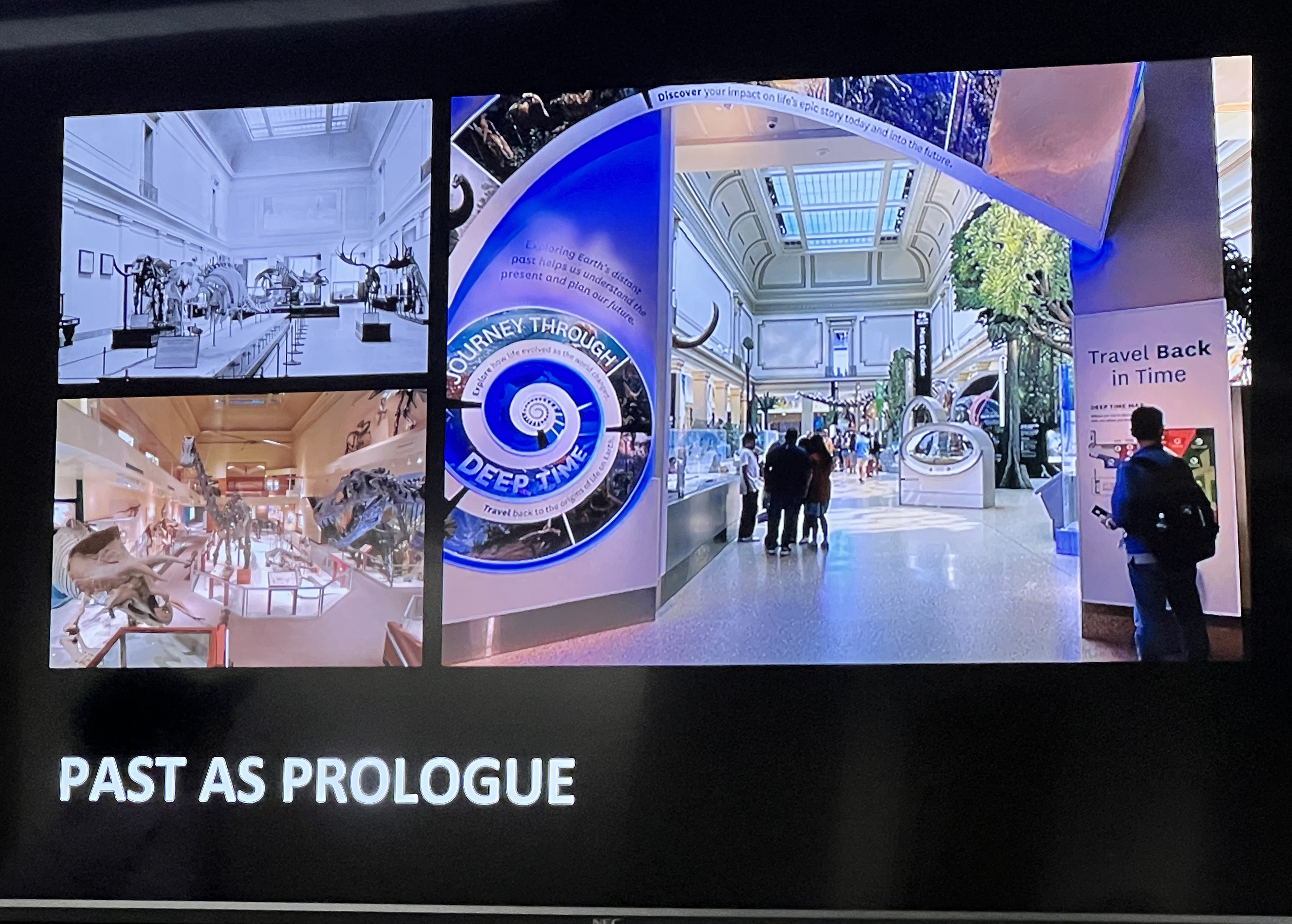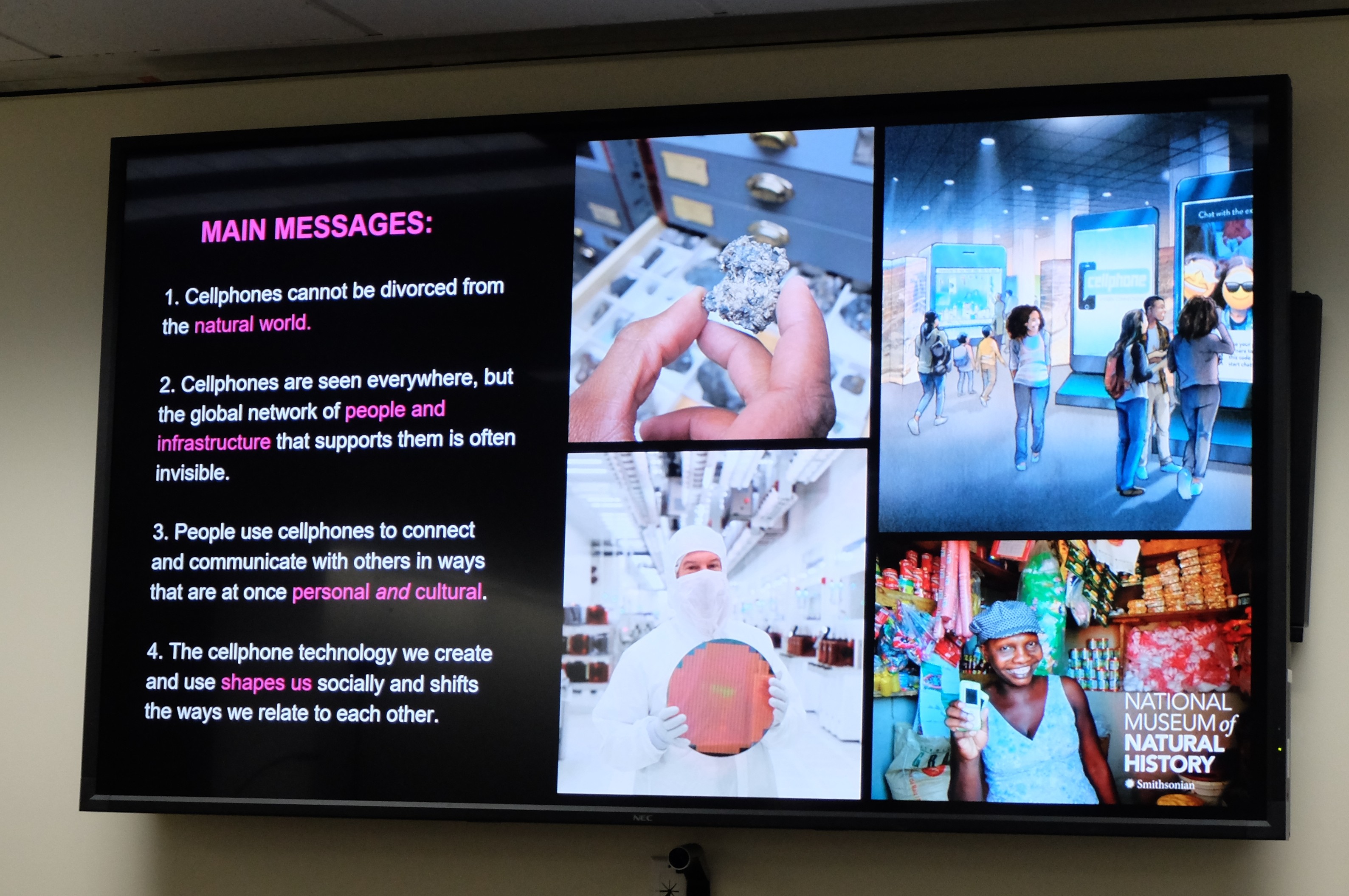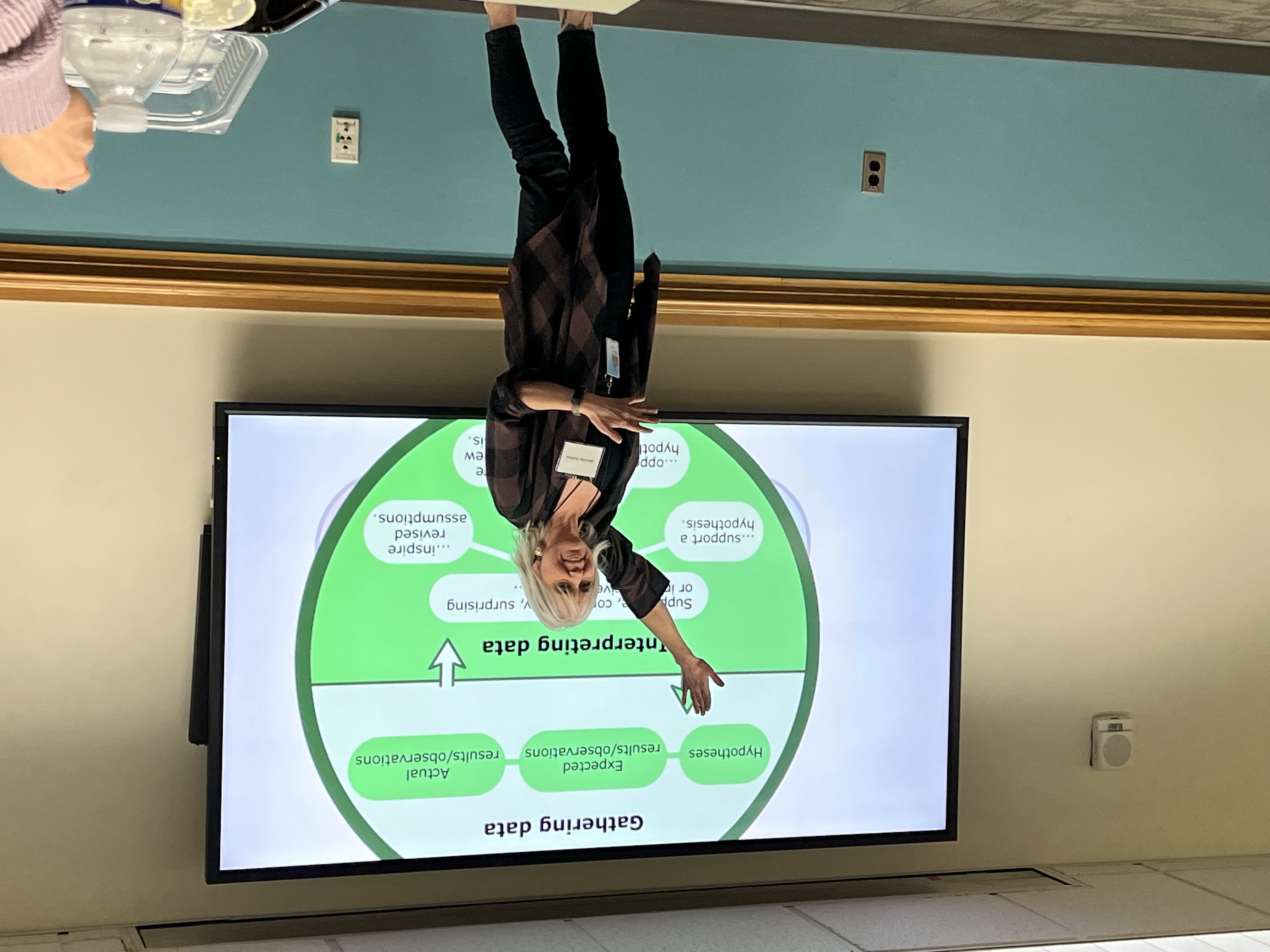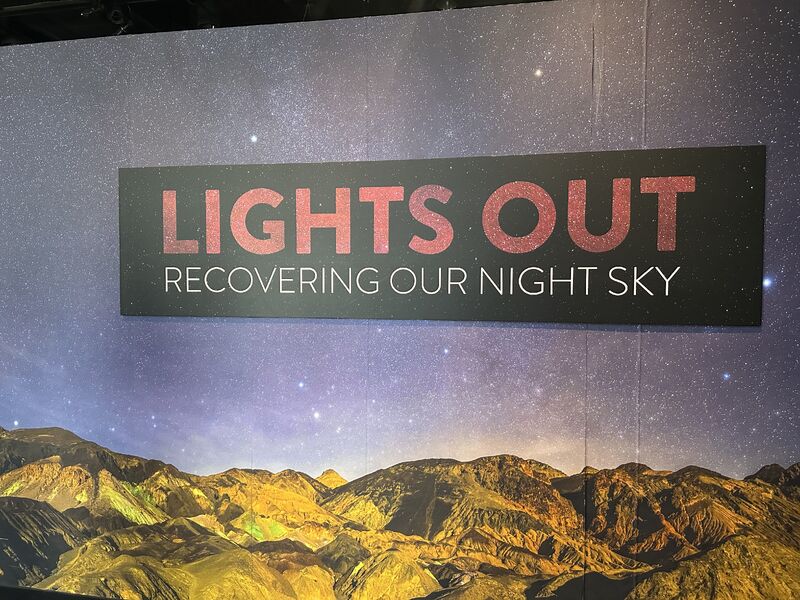By Professor Tiffany Banks On Tuesday, September 30th , students from my COMM 108: Foundations…
by Professor Matthew Decker
The Smithsonian Faculty Fellowship (SFF) braved the spring break crowds at the National Museum of Natural History (NMNH) last Thursday, March 27th. Before we had the chance to weave through the waves of other enthusiastic museumgoers in some of our favorite exhibits, though, we were treated to the expertise of not one, not two but four NMNH content experts. Together, Siobhan Starrs, Lauren Donnelly-Smith, Jennifer Collins, and Stephen Loring spoke to the design and impact of some of Natural History’s most fascinating spaces, including Deep Time, Cellphones: Unseen Connections, and Lights Out: Recovering Our Night Sky.
A veteran supporter of the SFF, Siobhan Starrs wears many hats. She has written and edited public-facing exhibit content and helped to develop and manage entire exhibition creation and revitalization projects. Her comprehensive understanding of every facet of an exhibit’s lifespan is especially palpable as she unpacks a somewhat sordid and comical history of what is now the David H. Koch Hall of Fossils – Deep Time. In 1910, many of the objects seen in Deep Time first appeared in the Hall of Extinct Monsters. Yes, monsters! Those poor dinosaurs! Before Jurassic Park and other media captured our imaginations, though, the skeletons on display in spaces like the Hall of Extinct Monsters were likely a visitor’s first experience of a dinosaur. As Starrs shares, though, this “cabinet of curiosities” lacked context interpretation. Later iterations of the same space made improvements but ran into other mistakes, such as compartmentalizing disciplines or neglecting accessibility needs.
projects. Her comprehensive understanding of every facet of an exhibit’s lifespan is especially palpable as she unpacks a somewhat sordid and comical history of what is now the David H. Koch Hall of Fossils – Deep Time. In 1910, many of the objects seen in Deep Time first appeared in the Hall of Extinct Monsters. Yes, monsters! Those poor dinosaurs! Before Jurassic Park and other media captured our imaginations, though, the skeletons on display in spaces like the Hall of Extinct Monsters were likely a visitor’s first experience of a dinosaur. As Starrs shares, though, this “cabinet of curiosities” lacked context interpretation. Later iterations of the same space made improvements but ran into other mistakes, such as compartmentalizing disciplines or neglecting accessibility needs.
Today, Deep Time endeavors to address all past missteps, forging a rich narrative-driven journey that constitutes the efforts of a multidisciplinary team in charge of important, sometimes challenging content. As a museum visitor who considers himself a bit of a completionist when it comes to exhibit exploration, I’ll admit to feeling overwhelmed whenever I wander through, but Starrs and the Deep Time team were aware of that potential response. That’s why the central story told is made clear with intentional design throughout the exhibit: big print, distinct timeline markers, numerous interactives, citizen-scientist supported short films, photo opps, real science in real time—you name it, the curators have realized it! The secret to impactful information-sharing seems to be touchpoints plural. Just consider the “Dinosaurs Take to the Air” display. In this one space, the casual visitor is invited to learn the trajectory of dinosaur-to-bird evolution with multiple forms of interaction: a stunning overhead mural, a DaVinci-esque bird machine, four real fossil impressions, a content-rich information panel, and even an animated diagram of a bird in flight. I dare you: Try to walk away from this display without understanding the curating team’s purpose! If you’d rather wait for the spring break hordes to thin out, though, take advantage of this exceptional virtual tour: https://naturalhistory2.si.edu/vt3/NMNH/z_tour-024.html.
 While a bit more unexpected among the Natural History museum’s labyrinthine halls, Cellphones: Unseen Connections is another fascinating space designed to facilitate wonder, discovery, and even nostalgia. Lauren Donnelly-Smith, an Exhibit Writer/Editor at Smithsonian Institution, introduced the Fellows to the whirlwind project of bringing this unique exhibit to life. Under the direction of Joshua Bell, the exhibition’s lead curator and the NMNH’s curator of globalization, cellphones are positioned as a story relevant to humanity, ecology, and natural history. They are also a clever way to drive youth engagement. In fact, digital natives from ages 13 to 25 are the target demographic, and a teen advisory board even helped to vet the content envisioned by the curators. That’s one reason why so many interactives throughout the space are designed to be fun and playful, encouraging visitors to engage immediately. Ideally, too, they are recognizing the harsh realities tied to resource extraction, workers’ rights, phone addiction, and more. “Now What?!” is a particularly thought-provoking stop on the hub and spoke journey that defines the exhibit’s flow. What do you do with your cellphone when it is less-than-functional? I’m picturing my iPhone SE that tragically died under the wheel of my in-motion bicycle last year. Many of us have a dead technology drawer at home, and it turns out that is one very common way to address the issue. Did you know, though, that, to decrease environmental impact, the best strategy is to maintain your current phone as long as you can? Battery charge, be damned!
While a bit more unexpected among the Natural History museum’s labyrinthine halls, Cellphones: Unseen Connections is another fascinating space designed to facilitate wonder, discovery, and even nostalgia. Lauren Donnelly-Smith, an Exhibit Writer/Editor at Smithsonian Institution, introduced the Fellows to the whirlwind project of bringing this unique exhibit to life. Under the direction of Joshua Bell, the exhibition’s lead curator and the NMNH’s curator of globalization, cellphones are positioned as a story relevant to humanity, ecology, and natural history. They are also a clever way to drive youth engagement. In fact, digital natives from ages 13 to 25 are the target demographic, and a teen advisory board even helped to vet the content envisioned by the curators. That’s one reason why so many interactives throughout the space are designed to be fun and playful, encouraging visitors to engage immediately. Ideally, too, they are recognizing the harsh realities tied to resource extraction, workers’ rights, phone addiction, and more. “Now What?!” is a particularly thought-provoking stop on the hub and spoke journey that defines the exhibit’s flow. What do you do with your cellphone when it is less-than-functional? I’m picturing my iPhone SE that tragically died under the wheel of my in-motion bicycle last year. Many of us have a dead technology drawer at home, and it turns out that is one very common way to address the issue. Did you know, though, that, to decrease environmental impact, the best strategy is to maintain your current phone as long as you can? Battery charge, be damned!
In the past, Cellphones: Unseen Connections has functioned as a rich playing ground for Fellows and their students. Regardless of discipline, there is truly something for everyone, whether it be the 65 elements that make up our beloved portable devices, the stories of changemakers in the field, or the nostalgia of the artifacts themselves. “Before Cellphones,” which includes a dynamic array of “past” communication drivers, is one example of a display that will inspire memories, chuckles, and even confusion. VHS tapes, for instance, were introduced in 1977. I wonder how many of our Gen Z streamers will recognize those “artifacts” on display!

Recognition, reflection, inquiry, debate—these activities and outcomes are central to the Smithsonian mission, which often tangos with difficult truths. Sometimes, the mission involves reframing misconceptions of big topics, including “science” itself. When Jennifer Collins, the Manager of Ocean Education and Outreach at the NMNH, asked the Fellows “What are common perceptions of science?” some of our more colorful responses included “it’s fake,” “it’s for boys and nerds,” and “it’s hard.” Even the scientific method contributes to this sense of gendered ivory tower inaccessibility due to its oft-presented step-by-step linearity. Collins underscores this is not how the Smithsonian values or “operates” science. Instead, Smithsonian educators position science as a non-linear, collaborative continuum where anyone can enter at any point. And that perspective ultimately invites people to connect with science at the museum. Whether through rolling education carts, like one centered on elephant teeth morphology (Such nuance!) or special collaborations with scientists and artists (like a project designed to interpret sonification of the night sky through dance) or regularly offered community events, there are always ways to experience science in action at the NMNH. Mark your calendars for an upcoming NMNH event: https://www.naturalhistory.si.edu/events. Soon, in conjunction with other Earth Day celebrations, the museum will host the Art x Climate Gallery, which features the artwork of 92 artists who embraced the call to bring art and science together to forge environmental action. Interested in a sneak peek? Take a look: https://nca2023.globalchange.gov/art-climate/.
 Finally—and I hope you’re still with me, dear reader, because our last guest speaker is such a gem—Stephen Loring, Anthropologist and Arctic Archeologist, is deeply tied to another SFF favorite: Lights Out: Recovering Our Night Sky. As a co-curator of the exhibit, Loring witnessed firsthand the unexpected flurry of interest that brought the space to life. Indeed, nearly every wing of the NMNH wanted to participate in the discussion of light pollution. The stunning photographs scattered throughout the exhibit were always planned, but then stories and artifacts relevant to birds, insects, sea turtles, and more naturally emerged. Light pollution is such a dramatic representation of human influence and that truth may speak to the exhibit’s profound impact on visitors. Last year, I left with the sad recognition that my own townhome community in Hyattsville, MD contributes to the problem with uncapped light posts. This year, I found myself stunned by the fact that the unique green lights used by fishing trawlers can be spotted from the International Space Station. It’s startling to know these vessels can be seen from space, but the everyday city dweller struggles to see the stars overhead.
Finally—and I hope you’re still with me, dear reader, because our last guest speaker is such a gem—Stephen Loring, Anthropologist and Arctic Archeologist, is deeply tied to another SFF favorite: Lights Out: Recovering Our Night Sky. As a co-curator of the exhibit, Loring witnessed firsthand the unexpected flurry of interest that brought the space to life. Indeed, nearly every wing of the NMNH wanted to participate in the discussion of light pollution. The stunning photographs scattered throughout the exhibit were always planned, but then stories and artifacts relevant to birds, insects, sea turtles, and more naturally emerged. Light pollution is such a dramatic representation of human influence and that truth may speak to the exhibit’s profound impact on visitors. Last year, I left with the sad recognition that my own townhome community in Hyattsville, MD contributes to the problem with uncapped light posts. This year, I found myself stunned by the fact that the unique green lights used by fishing trawlers can be spotted from the International Space Station. It’s startling to know these vessels can be seen from space, but the everyday city dweller struggles to see the stars overhead.
All is not lost, though, as Loring reminded us of the Earth Optimism theme that infuses Lights Out. There are very tangible strategies we can adopt to protect plants, insects, and animals affected by light pollution. For our own health, too, we can seek out dark skies. Here are some local options for you to investigate when your inner stargazer takes hold: https://go-astronomy.com/dark-sky-parks-stargazing-state.php?State=MD.
While this single visit to the National Museum of Natural History ultimately inspired nearly 1400 words, the truth is we are not even halfway done in 2025. Next up, the Fellows will take flight at the National Air and Space Museum. Stay tuned for more!
photos courtesy of Denise Dewhurst and Matthew Decker





This Post Has 0 Comments